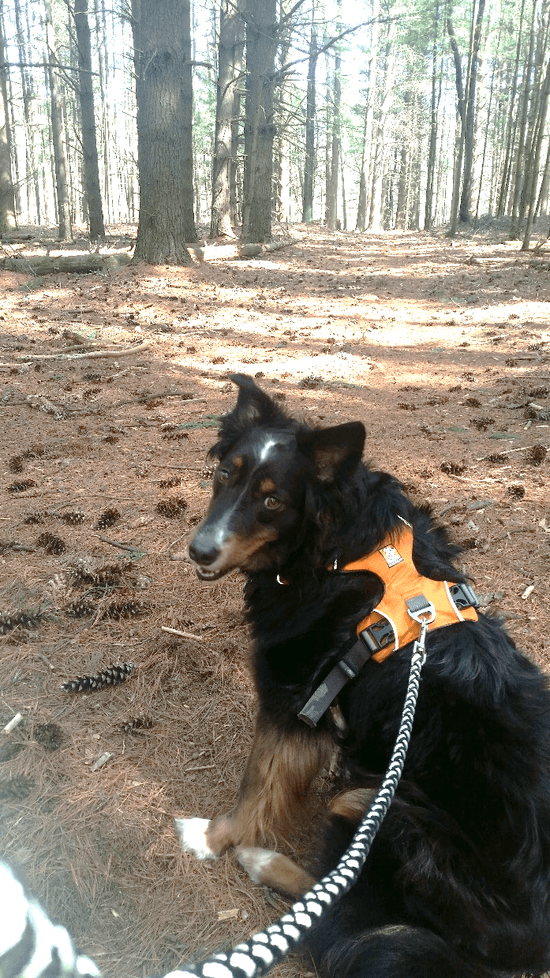




Contributing author and equine trail expert Lora Goerlich shares her thoughts on why leash laws need to be taken seriously.
by Lora Goerlich, Owner, Equestrian Trails and Facilities Consultant LLC

Recently I spent a week at The Park Ranger Institute Training in North Carolina. While teaching and advocating for equestrian trails I was engaged in countless discussions with rangers from across the United States about the rampant disregard for dog leash laws in city parks, state parks, national parks, county parks, metroparks; basically, everywhere but dog parks.
First and foremost, dog owners – please understand that taking a dog onto public park land requires strict adherence to rules. Second, leash laws mean: dog on leash + leash in hand. Not, dog dragging an attached leash or owner holding an unattached leash while the dog zigzags back and forth across the trail or crashing through the woods. Leashes must be visible, not electronic and the leash must not exceed a certain length; six to eight feet is common. An exception to leash laws might occur in public hunting areas where hunting with dogs is permitted and of course designated dog parks. Ultimately it is the dog owner’s responsibility to know and comply with the rules. Why? Because dog owners are liable for damage and injuries their dog causes while running at large (off leash) on public property.
But, but, but… “My dog is well behaved.” This is never guaranteed. By nature, dogs are predators and even the most well-behaved dog has the potential to act unpredictably. Disastrous outcomes are unlimited. I’ll save your brain, here are some examples:
1. Unleashed dog pursues a deer or other wildlife into a roadway directly in the path of a motor vehicle. The driver swerves in an effort to avoid hitting the deer and/or dog but strikes a pedestrian, or loses control and rolls the vehicle.
2. An unleashed dog attacks another dog or human.
3. Near equestrian trails, a loose dog could easily frighten a horse with potentially tragic consequences for horse and rider (Ohio, Gibson v. Donahue 2002).
4. Let’s say you’ve allowed your dog to drag its leash when suddenly your dog darts into the woods. No big deal, right? Wrong! A dog can easily become tangled with underbrush deep in the woods without ever being found. It will definitely suffer before dying.
5. An unleashed dog is an easy target for animals in their natural habitat including venomous and constricting snakes, birds of prey, wolves (both federally protected), alligators or moose to name a few.
6. Dogs have the innate potential to hunt and kill native wildlife or endangered wildlife.
“My dog is friendly.” There is no such thing as a friendly dog to a person who has a paralyzing fear of canines. Even the most pleasant dog can cause injury by inadvertently knocking a person down or getting tangled in the leash of another dog.
“There was no one else around.” Do you carry absurdly large periscope with you while at the park? My guess is no. (If you do… please, please contact me!) It is impossible to know who else is in the park, period.
There are no legitimate reasons for unleashing a dog where leash laws are in effect. Other enforceable canine related rules might include: solid dog waste removal, possession of current year dog registration and proof of current rabies vaccine.
To those who keep their dog leashed...thank you! Continue setting outstanding examples. If you’ve been negatively affected by an owner who allows their dog off leash, consider writing a detailed and factual complaint letter or email to the agency director, board members and/or city council members. This is an honest way to bring attention to ongoing, dog off leash, safety violations.
If you are caught with your dog off leash in a park or natural resource area and you receive a citation, you earned it. Take the citation graciously and own up to your disregard for rules and safety without belittling or arguing with the officer; moreover, don't do it again.
In the end, our safety, our beloved dog’s safety and natural resource balance are at risk every time we cross paths with a dog off leash.
posted Apr 17, 2024
This report summarizes guidance and best practices to create safer bicycle facilities and connect them into networks that allow more people to safely bike to more places within and throughout communities.
Setting Speed Limits for Health and Safety
posted Apr 17, 2024
This mini-report on setting speed limits shows the current framework for speed limit policies through a review of state laws that set speed limits.
posted Nov 14, 2023
These case studies reveal a number of lessons learned that will be valuable in future winter travel management planning efforts.
TRAILS SAFE PASSING PLAN: STOP, SPEAK, and STAND BACK
posted Feb 14, 2023
Horses are prey animals and naturally can be afraid of unfamiliar people and objects. Horses have natural "flight“ survival instincts and prefer to move their feet towards an exit route. Therefore, people with horses should pass at a walk while other trail users remain STOPPED until passed.
6,588 views • posted 07/14/2020